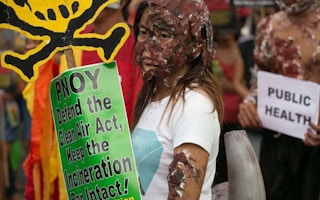The Philippine central bank will not consider fossil fuels in its proposed definitions of green finance but will not label waste-to-energy (WTE) as a high-risk activity.
To continue reading, subscribe to Eco‑Business.
There's something for everyone. We offer a range of subscription plans.
- Access our stories and receive our Insights Weekly newsletter with the free EB Member plan.
- Unlock unlimited access to our content and archive with EB Circle.
- Publish your content with EB Premium.
The regulator, known locally as the Bangko Sentral ng Pilipinas (BSP), stated that any expenditure related to the “exploration, production or transportation of fossil fuel and fossil-fuel power-generation related projects” as well as extractive mining will not be counted as “social and green”, in its draft sustainable finance framework released last month.
However, the draft does not include a managed coal phase out like Singapore and Indonesia, although the latter has backslided by announcing last month that it is considering a place for new coal-fired power plants in its green taxonomy.
Anti-mining non-profit Alyansa Tigil Mina (ATM) commended the BSP for putting extractives under the red label of activities considered harmful to the environment, stating that the sector will “impact the country’s goals and capacity to respond to climate change.”
The Philippine taxonomy will use the traffic light system to define types of activities viewed through a sustainability lens: green for activities that are “aligned with climate change mitigation and adaptation or undertaking a transition consistent with emissions-reduction”; amber for activities that “cause no harm, or if still causing some harm, the activity does not involve further carbon lock-in and has a time-horizon for reducing harm”; and red for activities that are excluded or “causing significant harm” to the environment.
A similar colour-coded classification system is used in the sustainable finance taxonomies of Singapore, Indonesia and the Association of Southeast Asian Nations (Asean).
The BSP said it sent the draft for public consultation to stakeholders, with a 6 October deadline for feedback before the policy is set to be officially launched by the first quarter of next year.
The document was made available online by Fair Finance Asia, a regional network of civil society organisations in the region, which published it on its social media page.
Commenting on the draft, Brex Arevalo, GAIA’s climate and anti-incineration campaigner said: “WTE is not included as high risk despite scientific evidence and legislation … It is converting fossil fuel-based plastic waste which generates fossil-fuel-sourced electricity. A major infrastructure project of this kind should be considered part of the exclusion list.”
The anti-waste burning advocacy group added that it was not one of the stakeholders consulted by BSP, but decided to submit its feedback.
The draft also allows for the entry of activites that cause significant harm as long as remedial climate mitigation and adaptation measures are made over a span of five years. Such activties are tagged as “amber” if attempts are made to mitigate that activity’s environmental impact within the transition period.
However, five years is “too long” because it opens a window even for industries known to have adverse environmental impacts to commit harm in the first place, like WTE, argued Arevalo.
“WTE projects will always have the potential to cause significant harm to climate mitigation and adaptation as they will always emit toxic and hazardous by-products like dioxins with half-lives of up to eleven years in the human body, regardless of technology or infrastructure used,” he said.
Waste burning in the Philippines is prohibited under the country’s Clean Air Act, but this has not stopped private companies from trying to construct waste incinerators that produce electricity.
Proponents of WTE have argued that there is no total ban on incineration according to local laws, contrary to what environmental groups claim. The only incineration that is illegal is that which produces “poisonous and toxic fumes”, which will not be emitted if the right pollution control technology is used, local government officials have pointed out.
Widely in use in countries including Japan, South Korea and northern Europe, WTE technology is making inroads in Southeast Asia, where it is promoted as a reliable green energy solution.
Southeast Asia is home to some of the world’s biggest sources of ocean pollution, which has helped WTE gain credibility as a solution to plastic pollution in countries with weak waste management infrastructure, such as Indonesia, Thailand and the Philippines.
Correction note (25 October): The original version of the article stated that GAIA was one of the stakeholders consulted in BSP’s public consultation. GAIA has clarified that it was not part of the consultation. The article has been amended to reflect this.
Want more Philippines ESG and sustainability news and views? Subscribe to our Eco-Business Philippines newsletter here.

















